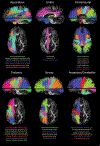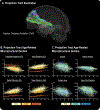Aging and white matter microstructure and macrostructure: a longitudinal multi-site diffusion MRI study of 1218 participants
- PMID: 35604444
- PMCID: PMC9648053
- DOI: 10.1007/s00429-022-02503-z
Aging and white matter microstructure and macrostructure: a longitudinal multi-site diffusion MRI study of 1218 participants
Abstract
Quantifying the microstructural and macrostructural geometrical features of the human brain's connections is necessary for understanding normal aging and disease. Here, we examine brain white matter diffusion magnetic resonance imaging data from one cross-sectional and two longitudinal data sets totaling in 1218 subjects and 2459 sessions of people aged 50-97 years. Data was drawn from well-established cohorts, including the Baltimore Longitudinal Study of Aging data set, Cambridge Centre for Ageing Neuroscience data set, and the Vanderbilt Memory & Aging Project. Quantifying 4 microstructural features and, for the first time, 11 macrostructure-based features of volume, area, and length across 120 white matter pathways, we apply linear mixed effect modeling to investigate changes in pathway-specific features over time, and document large age associations within white matter. Conventional diffusion tensor microstructure indices are the most age-sensitive measures, with positive age associations for diffusivities and negative age associations with anisotropies, with similar patterns observed across all pathways. Similarly, pathway shape measures also change with age, with negative age associations for most length, surface area, and volume-based features. A particularly novel finding of this study is that while trends were homogeneous throughout the brain for microstructure features, macrostructural features demonstrated heterogeneity across pathways, whereby several projection, thalamic, and commissural tracts exhibited more decline with age compared to association and limbic tracts. The findings from this large-scale study provide a comprehensive overview of the age-related decline in white matter and demonstrate that macrostructural features may be more sensitive to heterogeneous white matter decline. Therefore, leveraging macrostructural features may be useful for studying aging and could facilitate comparisons in a variety of diseases or abnormal conditions.
Keywords: Aging; Diffusion MRI; Tractography; Volume; White matter.
© 2022. The Author(s), under exclusive licence to Springer-Verlag GmbH Germany, part of Springer Nature.
Figures






Similar articles
-
White matter microstructure across the adult lifespan: A mixed longitudinal and cross-sectional study using advanced diffusion models and brain-age prediction.Neuroimage. 2021 Jan 1;224:117441. doi: 10.1016/j.neuroimage.2020.117441. Epub 2020 Oct 9. Neuroimage. 2021. PMID: 33039618
-
Ageing and brain white matter structure in 3,513 UK Biobank participants.Nat Commun. 2016 Dec 15;7:13629. doi: 10.1038/ncomms13629. Nat Commun. 2016. PMID: 27976682 Free PMC article.
-
Changes in White Matter Microstructure Over 3 Years in People With and Without Stroke.Neurology. 2023 Apr 18;100(16):e1664-e1672. doi: 10.1212/WNL.0000000000207065. Epub 2023 Feb 15. Neurology. 2023. PMID: 36792378 Free PMC article.
-
The Shape of the Brain's Connections Is Predictive of Cognitive Performance: An Explainable Machine Learning Study.Hum Brain Mapp. 2025 Apr 1;46(5):e70166. doi: 10.1002/hbm.70166. Hum Brain Mapp. 2025. PMID: 40143640 Free PMC article. Review.
-
Tractometry of Human Visual White Matter Pathways in Health and Disease.Magn Reson Med Sci. 2024 Jul 1;23(3):316-340. doi: 10.2463/mrms.rev.2024-0007. Epub 2024 Jun 12. Magn Reson Med Sci. 2024. PMID: 38866532 Free PMC article. Review.
Cited by
-
Multiomics identify the gene expression signature of the spinal cord during aging process.Commun Biol. 2025 Feb 7;8(1):193. doi: 10.1038/s42003-025-07475-4. Commun Biol. 2025. PMID: 39920442 Free PMC article.
-
Spatial transcriptomics of the aging mouse brain reveals origins of inflammation in the white matter.Nat Commun. 2025 Apr 4;16(1):3231. doi: 10.1038/s41467-025-58466-2. Nat Commun. 2025. PMID: 40185750 Free PMC article.
-
Neuropathological and sociodemographic factors associated with the cortical amyloid load in aging and Alzheimer's disease.Geroscience. 2024 Feb;46(1):621-643. doi: 10.1007/s11357-023-00982-4. Epub 2023 Oct 23. Geroscience. 2024. PMID: 37870702 Free PMC article.
-
Age-Trajectories of Higher-Order Diffusion Properties of Major Brain Metabolites in Cerebral and Cerebellar Gray Matter Using In Vivo Diffusion-Weighted MR Spectroscopy at 3T.Aging Cell. 2025 May;24(5):e14477. doi: 10.1111/acel.14477. Epub 2025 Jan 16. Aging Cell. 2025. PMID: 39817637 Free PMC article.
-
Testing retrogenesis and physiological explanations for tract-wise white matter aging: links to developmental order, fiber calibre, and vascularization.Geroscience. 2025 Jul 15. doi: 10.1007/s11357-025-01773-9. Online ahead of print. Geroscience. 2025. PMID: 40660078
References
-
- Bigham B, Zamanpour SA, Zare H (2022) Alzheimer’s disease neuroimaging I. Features of the superficial white matter as biomarkers for the detection of Alzheimer’s disease and mild cognitive impairment: a diffusion tensor imaging study. Heliyon 8(1):08725. 10.1016/j.heliyon.2022.e08725 - DOI - PMC - PubMed
Publication types
MeSH terms
Grants and funding
LinkOut - more resources
Full Text Sources

